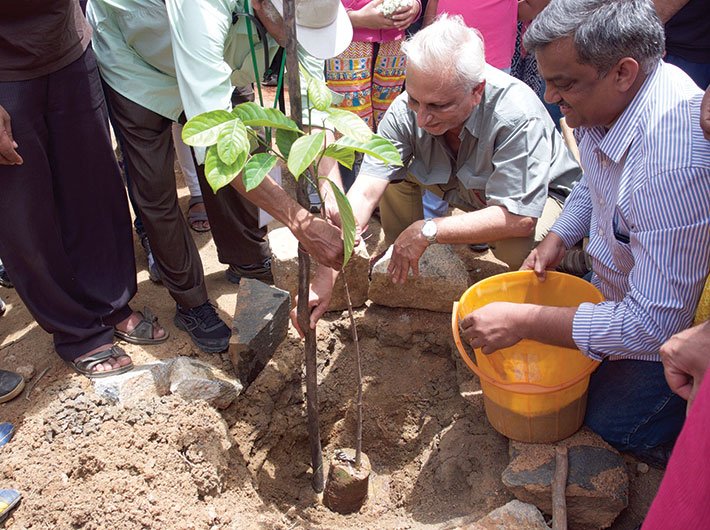As scientists claim that trees make people healthy and happy, a look at novel afforestation initiatives across the globe
A tree in the backyard keeps the doctor away? Maybe that should be the new-age mantra for good health. A paper published by the University of Chicago researchers, in the journal Scientific Reports in July, looked at urban trees kept by the city of Toronto and the health of the residents there.
It found that an increase of 11 trees per city block was comparable to an increase in annual personal income of $20,000. The increase in the number of trees in the street tallied with decrease in prevalence of cancer, diabetes, mental health problems, heart disease, stroke and even obesity.
In India as in the world, planting trees has mostly been confined to social forestry done by the forest department so far. But now it is finding place in the schemes of humanitarian groups, social enterprises out to earn for a noble social cause, and even in the architectural designs of skyscrapers. Here we take a look at three such initiatives:
My Tree
It is the new project of the humanitarian group Manav Ekta Mission (MEM) started by Sri M, a spiritual guide, social reformer and educationist. My Tree (punning on ‘maitri’ or friendship) is the brain child of Sri M who recently led and completed the Walk of Hope from Kanyakumari to Kashmir under the banner of the MEM. Inaugurated in Kerala in June with chief minister Pinarayi Vijayan planting the first sapling, My Tree is now fast moving along the route that was taken by the padayatris of the Walk of Hope, helped by volunteers who were part of the walk.
This is the very first outcome of the walk, says Balaji Kashyap, convenor, MEM. “One of the findings of the Walk of Hope, as it covered different parts of the country, was the acute need for trees. And the walk has given us groups of volunteers in all parts of the country who are eager to continue the work. So My Tree was the result,” he says.
My Tree has two aspects: social forestry and individual adoption. Under the former, MEM volunteers in various parts of the country identify spaces in private and public land and plant trees of local variety and then take care of it till they are grown up. Under individual adoption, people would be asked to have a sapling planted in a place of their choice or one identified by MEM and name it after some special occasion or a relative and so on, and then be associated with its upkeep forever along with MEM volunteers.
For Sri M, what is more important than planting saplings is to ensure that they are sustained. So numbers are not the only or chief criterion, says Kashyap.
For the social forestry wing of My Tree, the focus is on educational institutions, which collaborated across the country with Sri M during the Walk of Hope. “The padyatris stayed mostly in school and college campuses all the way to Srinagar. We want to synergise that goodwill and trust in Sri M into something that will truly bring us together for a common cause. For trees have no caste or religion and are same for all,” says Kashyap summing up the idea of ‘maitri’ that is at the heart of the project. One of the most recent plantation drives was done at Prasanthi Nilayam, a school for special children in Bengaluru.
My Tree is also a bit different from other afforestation projects being carried out by the government or the corporate sector – other initiatives involve planting a sapling and then forgetting about it, but under My Tree it is your tree for life. “Besides, for many it is an expression of confidence in someone like Sri M who they got to know through the walk. So it has a certain credibility and deeper meaning,” says Kashyap.
“But for these key ingredients, we could just be running after numbers,” he says.
“We need something to glue us together. And these trees would serve that purpose,” says Kashyap. “That is M Sir’s message through My Tree.”
Forest in the backyard
Another tree plantation effort that is changing attitudes and landscapes rapidly is Afforestt. Started in 2011 by Shubhendu Sharma, it is being embraced by many people across the world, including in the US, Singapore and Pakistan. The company helps people grow a forest of any size upward of 100 sqm anywhere they want. It has been appreciated recently in the Netherlands where the government has agreed to grow 100 forests in the urban lands in collaboration with the company.
Sharma quit his corporate job at Toyota after being inspired by the forest growing technique of a Japanese botanist named Akira Miyawaki and decided to spend the rest of his life implementing it.
“Our dream is that the idea spreads and we have people all over the world cloning the idea and greening the planet,” says Sunny Verma, a native of Uttarakhand, like Sharma and his associate, for the past four years.
One might wonder how much land would be good enough to raise a forest. “If you have a space to park six cars then that would give you a good enough forest,” says Verma who is executive director of the firm.
The minimum space required is 100 sqm, he says. The maximum can be anything. The biggest forest they have done so far is in Hyderabad suburb Sankarapally for a resort and in Jaipur which is a huge 50-acre forest. Other forests are small and done for individuals and housing apartments in Delhi, Bengaluru and abroad.
The forests they create are special for the simple reason that they take up very little space and grow faster than a normal forest. Thus, though a forest would naturally take 600 to 1,000 years to mature, the forest grown by Afforestt in your backyard takes just 10 years to be a full-fledged one. “We plant saplings that are up to 80 cm high and pack them close,” says Verma.
This forest grows so dense in eight months that sunlight can’t reach the ground and hence individual trees begin competing for sunlight – another reason why it grows so tall and fast, says Verma, explaining the Miyawaki concept.
“The forest needs to be watered and weeded for the first two or three years. After that it is self-sustaining,” he says.
Afforestt charges a one-time payment of '5 lakh irrespective of the size of the forest and '10,000 per day for supervision charges, if required. So far, the company has planted 72 forests in 23 cities.
Vertical forests
Internationally afforestation efforts have blossomed in a unique architectural style called vertical forests. Evolved by Italian architect Stephano Boeri, it is a model for a sustainable residential building and helps vertical densification of nature within the city.
The first example of the vertical forest were two residential towers of 110 m and 76 m height, in Milan, with 900 trees (each measuring 3, 6 or 9 metres) and over 2,000 plants from a wide range of shrubs and floral plants. On flat land, each vertical forest equals, in amount of trees, an area of 7,000 sqm.
The goal of this project is mainly to increase the green cover and biodiversity. It is expected to attract birds and insects and thus pave the way for recolonisation of urban spaces by animal life.
Menon is a freelance journalist.
(The article appears in the Ausgust 16-31, 2016 issue of Governance Now)

